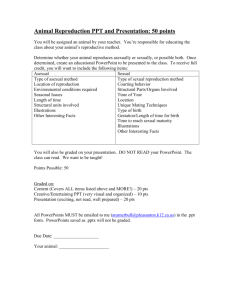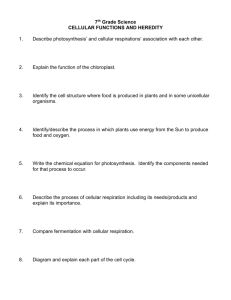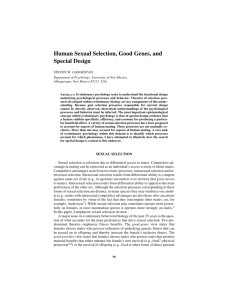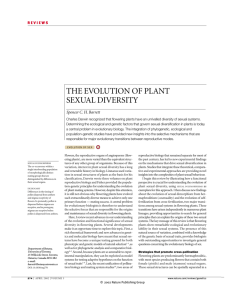What is an advantage of sexual reproduction
advertisement
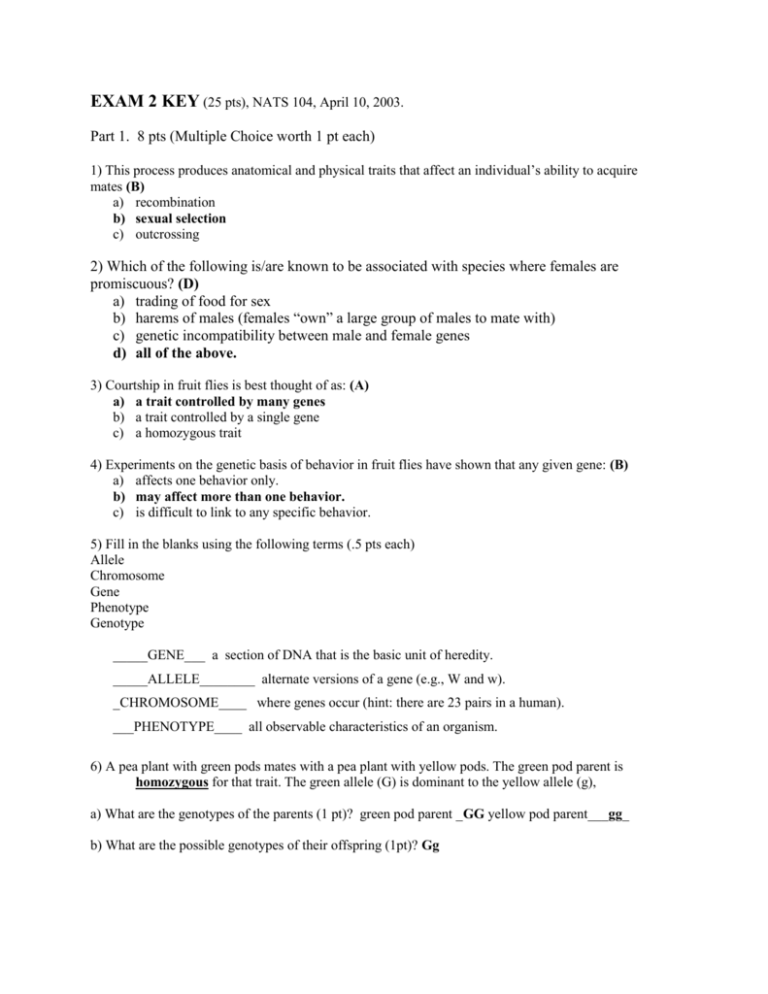
EXAM 2 KEY (25 pts), NATS 104, April 10, 2003. Part 1. 8 pts (Multiple Choice worth 1 pt each) 1) This process produces anatomical and physical traits that affect an individual’s ability to acquire mates (B) a) recombination b) sexual selection c) outcrossing 2) Which of the following is/are known to be associated with species where females are promiscuous? (D) a) trading of food for sex b) harems of males (females “own” a large group of males to mate with) c) genetic incompatibility between male and female genes d) all of the above. 3) Courtship in fruit flies is best thought of as: (A) a) a trait controlled by many genes b) a trait controlled by a single gene c) a homozygous trait 4) Experiments on the genetic basis of behavior in fruit flies have shown that any given gene: (B) a) affects one behavior only. b) may affect more than one behavior. c) is difficult to link to any specific behavior. 5) Fill in the blanks using the following terms (.5 pts each) Allele Chromosome Gene Phenotype Genotype _____GENE___ a section of DNA that is the basic unit of heredity. _____ALLELE________ alternate versions of a gene (e.g., W and w). _CHROMOSOME____ where genes occur (hint: there are 23 pairs in a human). ___PHENOTYPE____ all observable characteristics of an organism. 6) A pea plant with green pods mates with a pea plant with yellow pods. The green pod parent is homozygous for that trait. The green allele (G) is dominant to the yellow allele (g), a) What are the genotypes of the parents (1 pt)? green pod parent _GG yellow pod parent___gg_ b) What are the possible genotypes of their offspring (1pt)? Gg 2 Part 2. Short answer KEY (11 pts) 7) List three costs (disadvantages) of sexual reproduction with a brief description of each (3 pts). 1) 2) 3) 4) 5) Mating (takes energy, time, resources, can be damaging) Genetic (only half of genes are passed to offspring, esp. costly for the female) Cost of producing males (males don’t produce eggs or do parental care usually. Females are the limiting resource in terms of population growth, this is a numerical cost) Rarity (must find a member of the opposite sex which can be limiting in a sparsely populated setting or if migrating to an island or new habitat) Infection (can get a sexually transmitted disease) 8) List two benefits that have been proposed for sexual reproduction. (2 pt) 1) Genetic Variation (full credit if they just say variation) a. tangled bank (offspring can occupy diverse habitats) b. keep up in an evolutionary arms race with parasites (Red Queen) (1.5 pts if they put this and “variation”. 2) DNA repair or rejuvenation, repair of mutations 3) Clearing of mutations (Mueller’s Rachet). 9) What is outcrossing? Why is it so fundamental to sexual reproduction? (2) Outcrossing is mating with someone different (entirely unrelated is the most extreme outcrossing). It is fundamental because it is what generates the genetic variation or diversity, and the opportunity for repair of DNA, which are the two main proposed advantages to sexual reproduction. Inbreeding, cloning or selfing are the opposite of outcrossing. 10) List two different types of male-male competition. (2) 1) combat 2) sperm competition 3) mate guarding 4) alternative mating strategies 5) infanticide 11) What is an example of a species that experiences sexual selection? Why is it an example (not enough to say it has a long tail, or long call)? (2) Any example that can be justified gets full credit. Obvious ones are where they is pronounced sexual dimorphism in physical appearance or behavior (peacock, widowbird, gray tree frogs. Barn swallows, hangingflies, marine iguanas). Why? A pronounced physical or behavioral difference exists between males and females, and the character that varies gives advantages during mating, or provides an advantage during intrasexual competition, or intersexual choice. (full credit if they just have the information in the first line of this paragraph). 3 Part 3. Short essay KEY (6 pts, 3 pts each) 12) Describe the DNA repair theory presented by Dr. Michod in lecture and in your readings for why sexual reproduction exists. (3) Mutation (errors in the genetic code) are known to be common and a problem to be dealt with. One way to solve the problem is to outcross with someone who is unlikely to have the exact same errors in the exact same place. By outcrossing, the DNA is effectively rejuvenated because errors can be counteracted by good DNA of the mates. The same rejuvenation cannot work, by selfing of mating with yourself because you are more likely to have the same errors in multiple cells of your body that may have had the same parent cell. Mutations occur commonly in DNA. Evidence for this is the large amount of repair machinery that all cells have and the existence of many common mutagens. 13) Answer ONE and ONLY ONE of the following two questions. Cross out the one you do not want us to grade. Sexual selection can lead to traits that seem to oppose natural selection. Explain how using the example of body size in the marine iquana. (3) In the marine iquana, there is known to be an optimal size that has to do with the amount of algae available in the very crowded conditions where the iquanas live. The optimal size can be calculated because food is really the only non-mating-related limiting resource/factor for survival and reproduction in this species since predators are not a factor. Male iquanas are above optimal size, according to simple natural selection, and present an evolutionary puzzle. The explanation is that larger males get most of the matings in the marine iquana because larger males hold larger territories, and are visited by more females who mate with them on their territories. The large size helps them in male-male combat for the territories. Sexual selection drives male body size to be above the optimal size for survival independent of mating. Often male–male contests are a mixture of physical combat and ritualized display. Using red stags as an example, discuss how male-male competition in this species reflects a tradeoff between reliability of information and risk of physical injury. (3) In the red stag, males go through a series of ritualized “sequential assessment” behaviors in male-male dominance, competitive displays. First is show of horns and face to face, second is lining up sideways, third is locking horns, and escalating to fighting and possible injury. This reflects a tradeoff between getting a reliable indicator of male quality/strength through a method with low risk of injury, to a more reliable way to get truthful information on male quality/strength through fighting which has a high risk of injury. The sequence reflects a stepwise progression from low risk/low value information to high risk/high value information.
